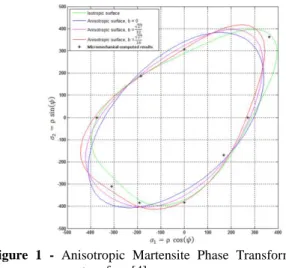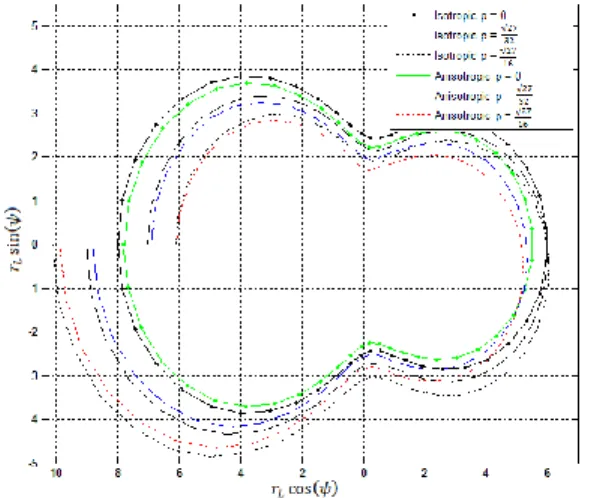Science Arts & Métiers (SAM)
is an open access repository that collects the work of Arts et Métiers Institute of
Technology researchers and makes it freely available over the web where possible.
This is an author-deposited version published in: https://sam.ensam.eu Handle ID: .http://hdl.handle.net/10985/11180
To cite this version :
Etienne PATOOR, Guillaume MOHARA, Dimitris CHATZIATHANASIOU, Yves CHEMISKY, George CHATZIGEORGIOU, Fodil MERAGHNI - Influence of phase transformation anisotropy on transformation surface around a crack tip - 2016
Any correspondence concerning this service should be sent to the repository Administrator : archiveouverte@ensam.eu
a)
Corresponding author. Email: etienne.patoor@georgiatech-metz.fr
INFLUENCE OF PHASE TRANSFORMATION ANISOTROPY
ON TRANSFORMATION SURFACE AROUND A CRACK TIP
Etienne Patoor
1,2,a), Guillaume Mohara
1, Dimitris Chatziathanasiou
3,
Yves Chemisky
3, George Chatzigeorgiou
3& Fodil Meraghni
31
School of Mechanical Engineering, Georgia Institute of Technology, GT-Lorraine, Metz, France
2
UMI 2958, Georgia Tech-CNRS, Metz, France
3
Arts et Métiers Paris Tech, LEM3 UMR 7239 CNRS, Metz, France
Summary A transformation criterion that includes the effect of tension-compression asymmetry and texture-induced anisotropy is used to describe the size of the transformation region surrounding the tip of an edge crack in a shape memory alloy. This analysis is made within the framework of the linear elastic fracture mechanics (LEFM). Different opening modes are considered. Transformation surfaces obtained are compared with those published by Lexcellent et al. (Int. J. Fract. 169: 1-13, 2011) for the isotropic case to capture the influence of transformation anisotropy for different fracture modes.
INTRODUCTION
Shape memory alloys are nowadays used in a wide range of applications developed for a variety of industrial fields. However, the necessity to better understand the interaction between cracks and stress-induced martensitic transformation is only a recent concern [1, 2]. Based on the linear elastic fracture mechanics framework, Lexcellent et al. have recently derived [1, 3] the stress field around a crack tip and have determined the phase transformation zone. They have shown that this result is dependant of the loading mode. These authors have taken into account the tension–compression asymmetry observed in SMAs and established that this asymmetry is responsible for the “peanut shape” of the transformation region in Mode 1.
Most of SMA applications are made from NiTi sheets or wires produced by rolling or by drawing. These elements are usually strongly textured. The present work aims to consider the influence of the crystallographic texture-induced anisotropy on the shape of the transformation zone using the new anisotropic transformation criterion developed by Chatziathanasiou et al. (2015) [4].
ANISOTROPIC TRANSFORMATION CRITERION
In order to take into account the texture-induced anisotropy the notion of alteration of the axes of the stress space is used
as introduced by Karafillis & Boyce [5]. A new space of stress * is considered that represents a distortion of the space of
real stresses. In this way the expression of the original transformation criterion is kept and Chatziathanasiou et al. [4] have proposed the following expression:
Φ(𝜎) = √𝐽2(𝜎∗) [1 + 𝑝 𝐽3(𝜎∗) 𝐽23⁄2(𝜎∗)] 1 2 − 𝑘𝜎= 0
Transformation surfaces obtained in that way are presented in figure 1 for different values of parameter p.
Figure 1 - Anisotropic Martensite Phase Transformation onset surface [4]
Figure 2 - Mode I, Anisotropic Martensite Phase Transformation onset surface under plane stress condition
DETERMINATION OF THE TRANSFORMATION ZONE AROUND A CRACK TIP
It is important to note that if the transformation is anisotropic we still assume that the elasticity remains isotropic. The determination of the transformation zone around a crack tip is then obtained considering the linear elastic fracture
mechanics framework approach as proposed in [1]. The stress tensor 𝝈∗ is considered instead of the real stress tensor. The
elastic stress field computed around the crack tip is investigated using the transformation criterion in order to determine the size and shape of the transformation surface. This is performed for different loading modes and different values of parameter p which characterizes the intensity of the asymmetry between tension and compression.
RESULTS
The onset zone limit for an anisotropic stress-induced transformation is determined for plane stress and plane strain conditions considering three different fracture modes. Results are compared with the isotropic ones presented in [1]. Material parameters are the same in both cases, only anisotropy differs. In Fig. 2 results for plane stress condition in Mode I are presented. Anisotropy generates a slightly smaller surface. Shape is globally conserved but it is shifted to the left. Surfaces obtained in Mode II are shown in Fig. 3. Here again, they are slightly smaller with respect to the isotropic ones, and is shifted downwards. The intersection of the three plots for a given configuration is not the same. For the isotropic case, the intersection is for ψ = 0, whereas it is around the (5;-1.5) coordinate for the anisotropic case. In Mode III the surface is a circular one as in the isotropic case (Fig. 4) but this surface is no longer independent of parameter p. This comes from the fact that the determinant of the anisotropic stress tensor is not equal to zero as this is the case for the isotropic one.
Figure 3 - Mode II, Anisotropic Martensite Phase Transformation onset surface for plane stress
Figure 4 - Mode III, Anisotropic Martensite Phase Transformation onset surface for plane stress
CONCLUSIONS
The notion of alteration of the axes of the stress space to describe the influence of texture-induced anisotropy allows extending fracture analysis in SMAs. Prediction of the phase transformation onset zones around a crack tip is obtained for three loading modes in plane stress and plane strain conditions. It appears that anisotropic surfaces are slightly smaller than isotropic ones while still displaying the same trend. Moreover, a light but noticeable shift of theses surfaces can be observed for all modes.
References
[1] Lexcellent C., Laydi M.R., Taillebot V.: Analytical prediction of the phase transformation onset zone at a crack tip of a shape memory alloy exhibiting asymmetry between tension and compression. Int. J. Fract. 169: 1-13, 2011.
[2] Baxevanis T., Parrinello A.F., Lagoudas D.C.: On the fracture toughness enhancement due to stress-induced phase transformation in shape memory alloys. Int. J. Plast. 50: 158–169, 2013.
[3] Lexcellent C., Thiebaud F.: Determination of the phase transformation zone at a crack tip in a shape memory alloy exhibiting asymmetry between tension and compression. Scripta Materialia 59: 321-323, 2008.
[4] Chatziathanasiou D., Chemisky Y., Meraghni F., Chatzigeorgiou G., Patoor E.: Phase transformation of anisotropic shape memory alloys: Theory and validation in superelasticity. Shap. Mem. Superelasticity, DOI 10.1007/s40830-015-0027-y, 2015.
[5] Karafillis A.P., Boyce M.C.: A general anisotropic yield criterion using bounds and a transformation weighting tensor. J. Mech. Phys. Solids 41, (12): 1859-1886, 1993.

